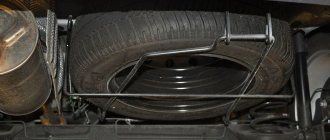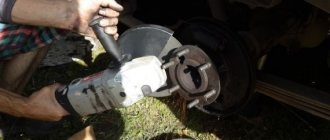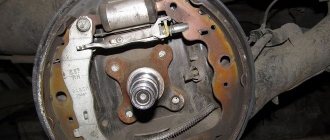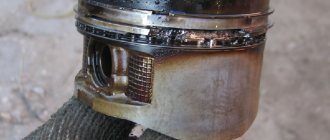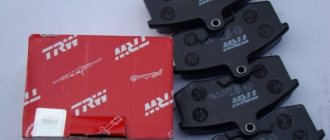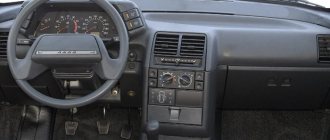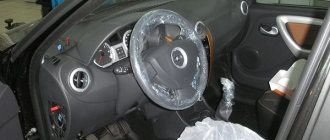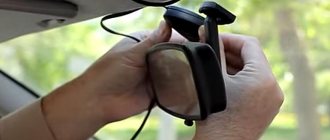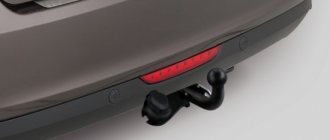First of all, it is worth mentioning the responsibility when removing the airbag from a Lada Largus car. So, if you deviate from the technological process of removing the airbag, it can work and cause injury. Also, the airbag is disposable. If it works, it will have to be replaced with a new one. Attempting to remove an airbag module without disconnecting its power supply may result in unexpected deployment of the airbag. You can begin subsequent operations to remove the airbag only after the activator capacitor has completely discharged. To do this, you must wait at least 15 minutes after turning off the power supply. Do not disassemble the airbag module. Do not drop the airbag module and do not allow water, grease or oil to come into contact with it. The airbag module must not be exposed to temperatures above 95 °C.
Operations for removing the airbag Lada Largus
1. Disconnect the wire from the negative terminal of the battery. 2. Compress the spring clips securing the airbag module while simultaneously inserting the rods into two special holes located on the sides of the steering wheel...
3. ...at the same time, an assistant must pull the airbag module towards himself with his hands and move it with the horn switch away from the steering wheel to the length of the connected wiring harnesses.
This is where the spring clamps for securing the airbag module are located.
4. Turn the steering wheel to a straight-ahead position.
5. Use a screwdriver to pry the clamp of the wiring harness block...
6. ...remove the retainer from the block...
7...and disconnect the block from the airbag. Remove the airbag. 8. Install the driver's airbag module in the reverse order of removal.
For most Lada Largus owners, the steering wheel is quite comfortable. But there are also many drivers who like to put either braids on the steering wheel or cover it. If you are planning to sheathe it, then the ideal option would be to completely dismantle the steering wheel in order to complete this work without unnecessary inconvenience.
How to remove the airbag on a Largus
The front passenger airbag is located in the instrument panel on the passenger side and consists of a folded airbag shell and an inflator.
The passenger airbag module differs from the driver's airbag in shape and larger volume;
When installing a child seat in the front passenger seat, deactivate the passenger airbag.
To turn off the airbag, open the front passenger door and turn the switch to the “OFF” position.
To remove the cushion you need tools: Torx T30 wrench, 10mm socket head.
We prepare the car for the task and disconnect the negative terminal of the battery
Attempting to remove an airbag module without disconnecting its power supply may result in unexpected deployment of the airbag.
You can begin subsequent operations to remove the airbag only after the activator capacitor has completely discharged.
To do this, you must wait at least 15 minutes after turning off the power supply.
Do not disassemble the airbag module.
Do not drop the airbag module and do not allow water, grease or oil to come into contact with it.
The airbag module must not be exposed to temperatures above 95 °C.
We remove the instrument panel, as described in the article - How to remove the instrument panel of Lada Largus
Unscrew the four nuts securing the airbag module to the instrument panel
We remove the wiring harness from one holder
We remove the wiring harness from the other holder
Remove the wiring harness from the third holder on the panel
And remove the front passenger airbag module
Install the airbag module in reverse order
Necessary tools and procedure for removing and installing the steering wheel
The repair principle is no different from the Renault Logan car, which is a complete analogue of Largus. An example will show how to work with a driver's airbag.
First of all, disconnect the negative terminal from the battery.
After this, using two rods with a diameter of about 5 mm from the inside, we insert them into the holes of the airbag module. One of the holes is clearly shown in the photo below:
Then we apply a little force, and at the same time carefully lift the module up and disconnect the power cord, which is clearly shown in the photo:
When the plug is disconnected, you can unscrew the steering wheel mounting bolt using a special bit with a TORX T50 profile, but not completely. Then from the inside we try to knock the steering wheel off the splines, and after that we finally unscrew the fastening bolt.
And now you can easily remove the steering wheel and carry out all the necessary operations. Installation proceeds in reverse order.
Such a popular and sought-after car as the Lada Largus is equipped with a steering mechanism, which is a rack-and-pinion gear and a hydraulic booster. This Largus mechanism is secured to the front suspension subframe and mounted to it with two bolts.
Removing and installing the airbag switch
Disconnect the negative terminal of the battery
Opening the front passenger door
Turn the switch housing clockwise
Remove the switch from the hole in the instrument panel
Squeeze the wire block clamp
And disconnect the block from the switch. Removing the switch
Install the front passenger airbag switch in the reverse order.
Possible malfunctions of the steering mechanism
- If the steering wheel has increased free play and a knocking sound is heard, it is possible that the spring tension is broken, the universal joint or ball joint is worn out, or the bolts are loose. Ways to solve the problem may be tightening the bolts, replacing the driveshaft or joints.
- If the steering wheel rotates tightly, the cause of the malfunction may be air entering the hydraulic system, damage to the distributor or steering gear seals, or wear of the pump drive belt, as well as low pressure of the power steering pump, or damage to the hoses. A possible remedy is to replace the seal, belt, and other defective pump parts. It would also be a good idea to restore the optimal fluid level and eliminate hose kinks.
- If the steering wheel does not clearly return to the middle position, you should pay attention to such malfunctions as damage to the following parts: pressure control valve, pump rotor shaft bearing, gear bearing, hose. The steering shaft seal or universal joint may also be worn out, or the hose may be kinked. The situation can be corrected by replacing the bearing, pressure control valve or other parts of the mechanism. It may also be necessary to replace the tie rod ends and adjust the spring tension.
- When a knocking noise is heard in the steering, this may be the result of loose tie-rod ball joints or loose tie rods. Also, knocking occurs due to wear of parts such as ball joints and steering rods. The hoses may also touch the body. The problem can be fixed by tightening the fasteners, replacing worn parts, or correctly positioning the hoses.
- When increased noise occurs, this means that air has entered the hydraulic system, there is not enough working fluid, or the pump mounting bolts are loose. In this case, it is necessary to remove the air, add fluid, or tighten the bolts.
Characteristics of power steering of Lada Largus
This unit is no less important than the brake system. The safety of the driver and passengers also depends on its performance. Power steering (hydraulic power steering) provides the ability to control the car by easily positioning the drive wheels in the desired direction.
The Lada Largus is equipped with a combined type hydraulic booster, i.e. some of its elements are located directly in the steering mechanism housing. In other words, they are a component of the mechanical part of the steering column. Power steering Lada Largus consists of a standard set of elements:
- tank;
- power steering pump, complemented by a working fluid bypass valve;
- pipelines;
- redistribution mechanism;
- working mechanism.
There are not many components, which explains the high reliability of the hydraulic booster. Malfunctions associated with its operation occur infrequently. Typically, problems arise due to violations of operating rules by the car owners themselves. Much less often - due to the natural wear and tear of parts, but, of course, one cannot ignore the low quality of components.
It's easy to check; just open the hood. The fluid in the system is also needed to lubricate the power steering elements. If the level is low, parts will begin to wear out too quickly. With such use, the unit is more likely to fail.

